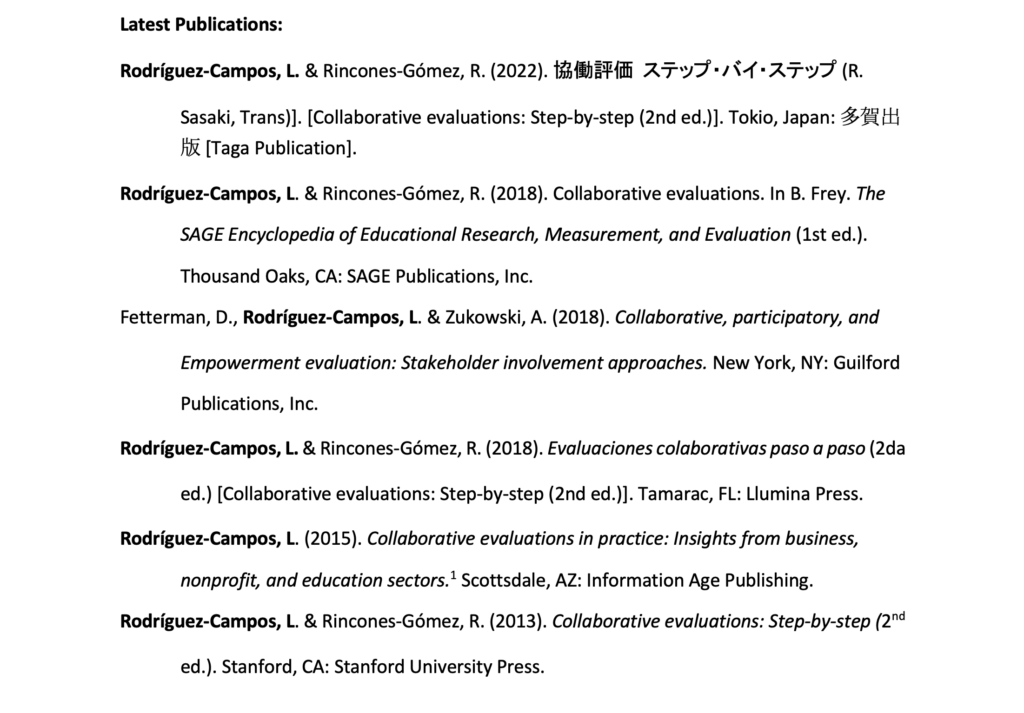Hello, AEA365 community! Liz DiLuzio here, Lead Curator of the blog. This week is Individuals Week, which means we take a break from our themed weeks and spotlight the Hot Tips, Cool Tricks, Rad Resources and Lessons Learned from any evaluator interested in sharing. Would you like to contribute to future individuals weeks? Email me at AEA365@eval.org with an idea or a draft and we will make it happen.

I am Liliana Rodríguez-Campos, Co-Chair of the Collaborative, Participatory, and Empowerment Evaluation TIG. I bring expertise as an evaluation professor and the director of the Graduate Certificate in Evaluation at the University of South Florida.
My contributions to the field have been recognized through various honors, including the AEA’s Marcia Guttentag Award. I am the author of the books: Collaborative Evaluations Step-by-Step 2nd ed. (available in English, Japanese, and Spanish); Collaborative Evaluations in Practice: Insight from Business, Education, and Nonprofit Sectors; and Collaborative, Participatory, and Empowerment Evaluation: Stakeholder Involvement Approaches. I have presented my work in 37 countries, and currently serve at evaluation luminary Dr. Michael Scriven’s Faster Forward Fund Advisory Committee. I am excited to share some tools and tips based on my extensive experience in the field.
Hot Tip:
Effective stakeholder involvement is essential to the success of collaborative evaluations. My approach includes utilizing specific components and their suggested step-by-step guidelines: (1) identify the situation, (2) clarify the expectations, (3) establish a collective commitment, (4) ensure open communication, (5) encourage effective practices, and (6) follow specific guidelines. While each component can provide valuable insights individually, a comprehensive evaluation can be achieved by using them interactively. For more information, please visit my LinkedIn page.
Rad Resources:

Model for Collaborative Evaluations (MCE)
The MCE is a comprehensive framework for guiding collaborative evaluations in a clear, realistic, and useful manner. This model has a systematic structure and revolves around six interactive components and respective subcomponents. Additionally, each of the subcomponents includes a set of 10 steps suggested for proper use. The model applicability can be as simple as using one single component or one single subcomponent.
Collaborative, Participatory, and Empowerment Evaluation TIG
Publications about evaluation in collaborative, participatory and empowerment evaluation are presented as well as blogs and links to websites containing useful information.
Free Evaluation Certificate Workshops (University of South Florida)
The Free Evaluation Certificate Workshops provide the audience with an opportunity to engage in dynamic discussions about evaluation.

Do you have questions, concerns, kudos, or content to extend this aea365 contribution? Please add them in the comments section for this post on the aea365 webpage so that we may enrich our community of practice. Would you like to submit an aea365 Tip? Please send a note of interest to aea365@eval.org . aea365 is sponsored by the American Evaluation Association and provides a Tip-a-Day by and for evaluators. The views and opinions expressed on the AEA365 blog are solely those of the original authors and other contributors. These views and opinions do not necessarily represent those of the American Evaluation Association, and/or any/all contributors to this site.

The link for the model goes to LinkedIn. Is there another way to access it?